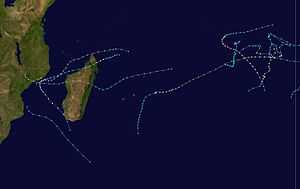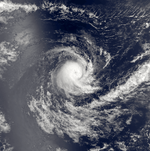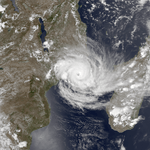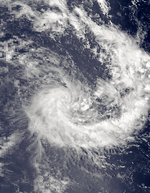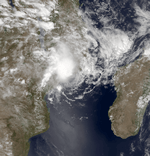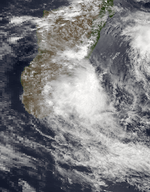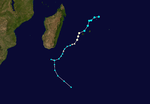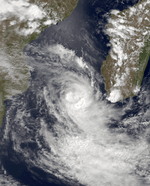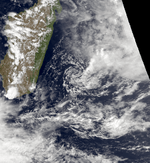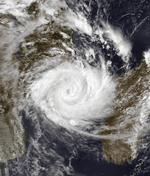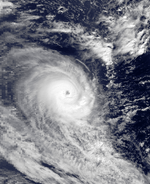1981–82 South-West Indian Ocean cyclone season
The 1981–82 South-West Indian Ocean cyclone season was an average cyclone season.
Season summary
Météo-France's meteorological office at Réunion (MFR) issued advisories for storms in the basin during the year. At the time, the MFR area of warning responsibility was from the coast of Africa to 80º E, and the agency primarily used the Dvorak technique to estimate the intensities of tropical cyclones.[1]
The Joint Typhoon Warning Center (JTWC), which is a joint United States Navy – United States Air Force task force that issues tropical cyclone warnings for the region,[2] also issued advisories for storms in the year. The agency tracked a tropical depression in July 1982. The system formed on July 4 southeast of Seychelles, and initially curved to the southwest. It failed to intensify beyond winds of 55 km/h (35 mph), and dissipated on July 4 after turning to the northwest.[3] At the time, the annual tropical cyclone year was from August 1 to July 31 of the subsequent year.[1]
Season summary

Severe Tropical Storm Bessi-Armelle
| Severe tropical storm (MFR) |
| Category 1 tropical cyclone (SSHWS) |
|
|
| Duration |
November 3 – November 20 |
| Peak intensity |
100 km/h (65 mph) (10-min) 976 mbar (hPa) |
Tropical Cyclone Benedicte
| Tropical cyclone (MFR) |
| Category 2 tropical cyclone (SSHWS) |
|
|
| Duration |
December 17 – December 25 |
| Peak intensity |
135 km/h (85 mph) (10-min) 954 mbar (hPa) |
Tropical Depression Clarissee
| Tropical depression (MFR) |
| Tropical storm (SSHWS) |
|
|
| Duration |
December 29 – January 7 |
| Peak intensity |
50 km/h (30 mph) (10-min) 990 mbar (hPa) |
Intense Tropical Cyclone Chris-Damia
| Intense tropical cyclone (MFR) |
| Category 4 tropical cyclone (SSHWS) |
|
|
| Duration |
January 6 – January 21 |
| Peak intensity |
215 km/h (130 mph) (10-min) 898 mbar (hPa) |
Intense Tropical Cyclone Chris-Damia was the strongest tropical cyclone in the South-West Indian Ocean ever recorded with a minimum pressure of 898 mbar (hPa) until Cyclone Gafilo broke the record with a minimum pressure of 895 mbar (hPa).
Moderate Tropical Storm Electre
| Moderate tropical storm (MFR) |
| Tropical storm (SSHWS) |
|
|
| Duration |
January 30 – February 6 |
| Peak intensity |
80 km/h (50 mph) (10-min) 984 mbar (hPa) |
Moderate Tropical Storm Frida
| Moderate tropical storm (MFR) |
| Tropical storm (SSHWS) |
|
|
| Duration |
January 31 – February 1 |
| Peak intensity |
65 km/h (40 mph) (10-min) 991 mbar (hPa) |
Moderate Tropical Storm Gabrielle
| Moderate tropical storm (MFR) |
| Category 1 tropical cyclone (SSHWS) |
|
|
| Duration |
February 5 – February 11 |
| Peak intensity |
80 km/h (50 mph) (10-min) 984 mbar (hPa) |
Tropical Depression Heberte
| Tropical depression (MFR) |
| Tropical storm (SSHWS) |
|
|
| Duration |
February 12 – February 14 |
| Peak intensity |
50 km/h (30 mph) (10-min) 997 mbar (hPa) |
Tropical Storm 20S
| Tropical storm (SSHWS) |
|
|
| Duration |
February 22 – February 25 |
| Peak intensity |
85 km/h (50 mph) (1-min) 989 mbar (hPa) |
Tropical Depression Isabeau
| Tropical depression (MFR) |
|
|
| Duration |
February 23 – February 24 |
| Peak intensity |
50 km/h (30 mph) (10-min) 997 mbar (hPa) |
Tropical Cyclone Justine
| Tropical cyclone (MFR) |
| Category 1 tropical cyclone (SSHWS) |
|
|
| Duration |
March 16 – March 25 |
| Peak intensity |
150 km/h (95 mph) (10-min) 941 mbar (hPa) |
Intense Tropical Cyclone Karla
| Intense tropical cyclone (MFR) |
| Category 3 tropical cyclone (SSHWS) |
|
|
| Duration |
April 23 – May 4 |
| Peak intensity |
170 km/h (105 mph) (10-min) 927 mbar (hPa) |
See also
- Atlantic hurricane seasons: 1981, 1982
- Eastern Pacific hurricane seasons: 1981, 1982
- Western Pacific typhoon seasons: 1981, 1982
- North Indian Ocean cyclone seasons: 1981, 1982
References
| 1980–1989 South-West Indian Ocean cyclone seasons |
|---|
| |
|
